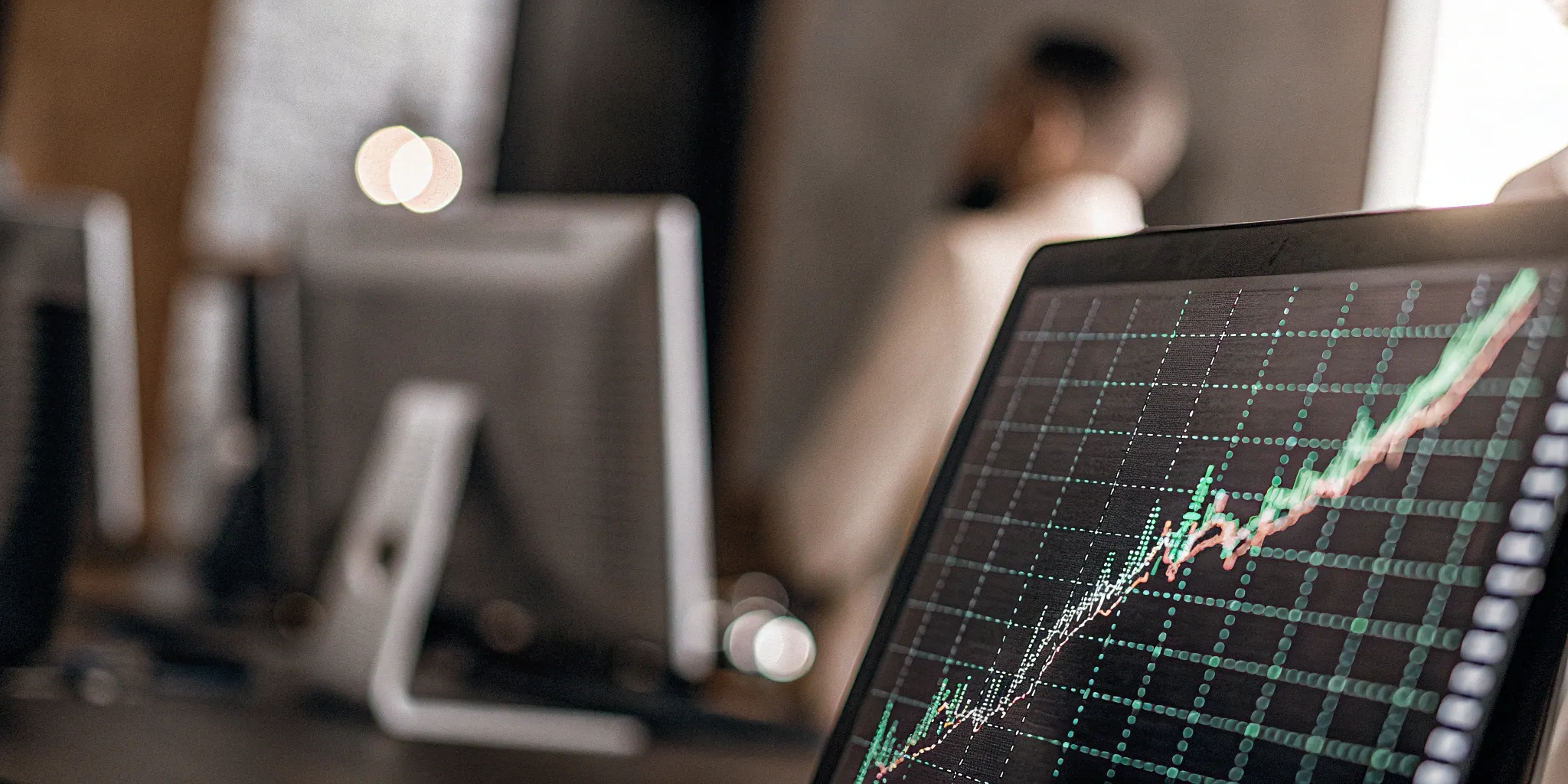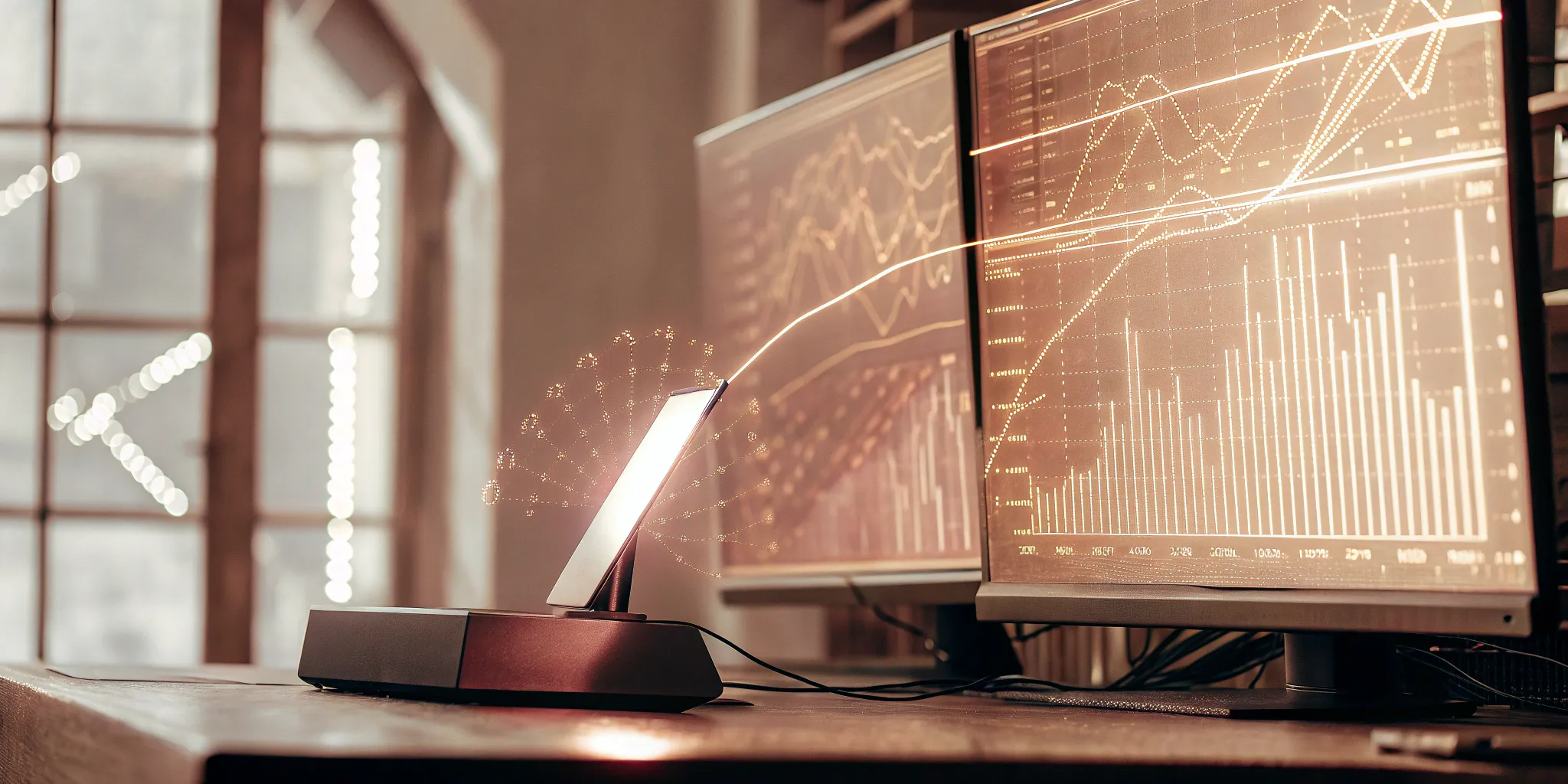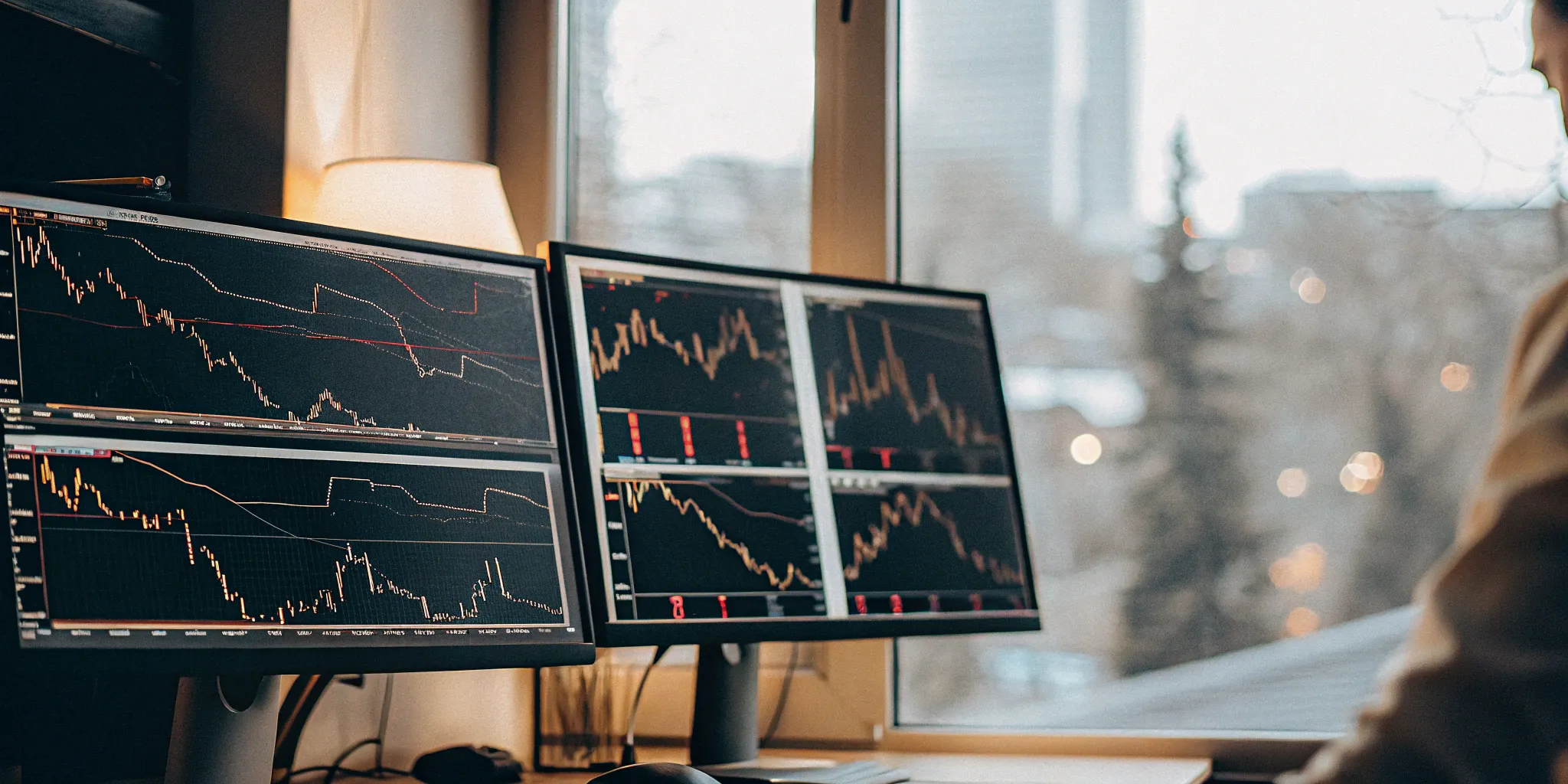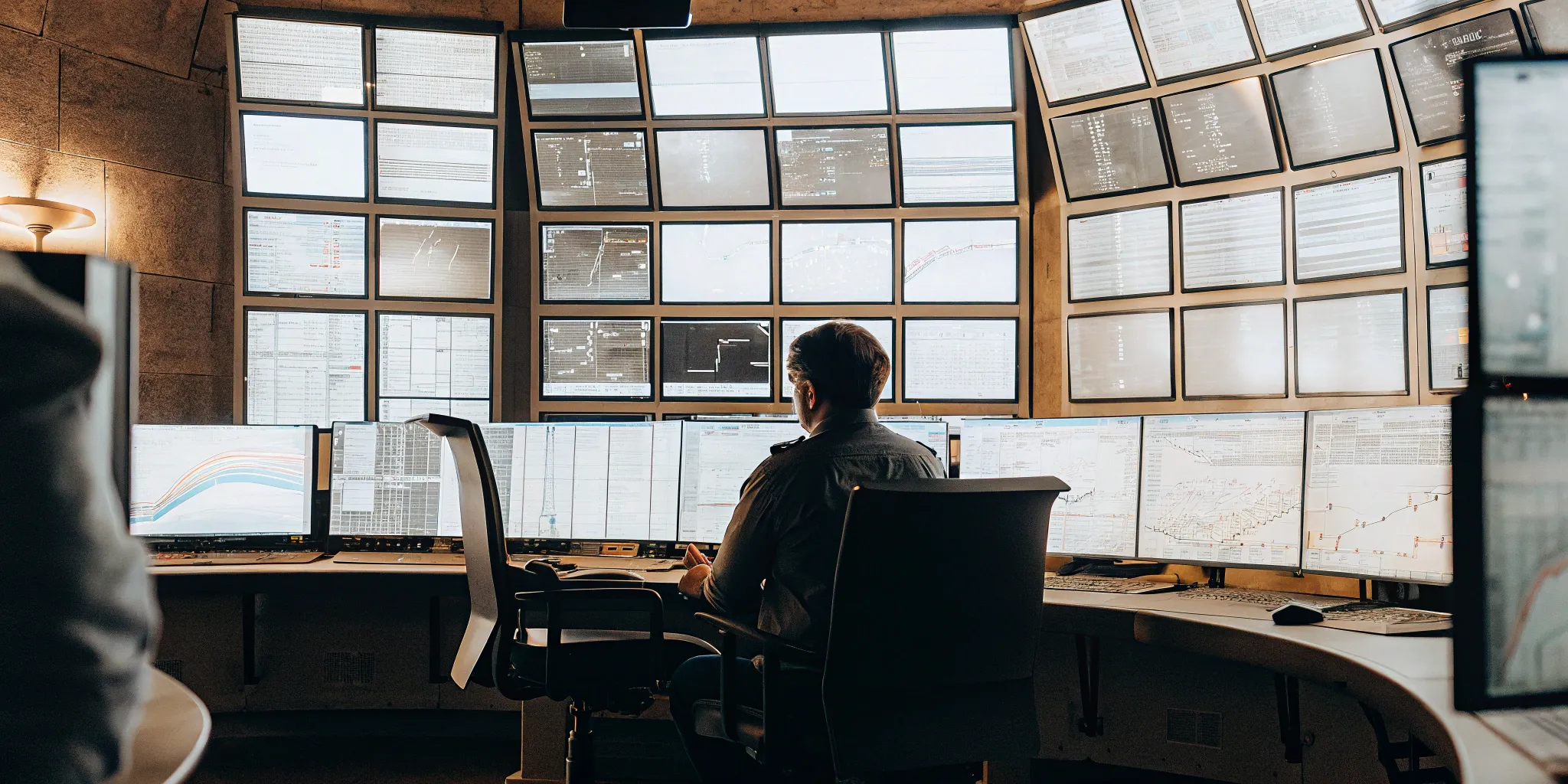Tired of staring at charts, second-guessing your decisions, and letting emotions cloud your judgment? Automatic trading software offers a solution by taking the human element out of the equation. By pre-defining your trading rules and letting the software execute trades automatically, you can achieve greater speed, efficiency, and emotional control. This guide will demystify automatic trading software, exploring its mechanics, benefits, risks, and the leading platforms available. Whether you’re intrigued by the potential of AI-driven algorithms or prefer a more hands-on approach, we’ll help you find the right tools and strategies to succeed in the world of automated trading.
Key Takeaways
- Automated trading software lets you define your strategy and execute trades automatically, eliminating emotional decisions and maximizing speed. This is especially helpful in fast-moving markets, but requires careful attention to risk management and potential technical issues.
- Choosing a platform depends on your trading style and experience. Beginners may prioritize ease of use, while experienced traders might need advanced features like backtesting and custom scripting. Consider costs, supported markets, and the quality of customer support.
- Monitor and adapt your automated strategies regularly. Track key performance indicators like win rate, profit factor, and maximum drawdown to assess effectiveness and adjust your approach as needed. Staying informed about market trends and refining your system is crucial for long-term success.
What is Automated Trading Software?
Automated trading software, also known as algorithmic trading software, lets you establish specific rules for entering and exiting trades, which the software then executes automatically. Think of it as handing off your trading strategy to a tireless robot. This automation removes emotional decision-making and allows for faster, more frequent trades than possible manually. This can be particularly helpful in fast-moving markets where opportunities can appear and disappear in seconds. Automated trading systems can range from simple, rule-based systems to complex algorithms using machine learning. No matter the complexity, the core principle remains: defining your strategy and letting the software execute the trades. At FN Capital, our FAST AI algorithm embodies this principle, executing thousands of trades per month on your behalf. Learn more about how our AI-powered trading can work for you.
How Automated Trading Software Works
Setting up automated trading typically involves a few key steps. First, you’ll choose a trading platform that supports automated trading, such as MetaTrader 4/5, cTrader, or a proprietary system like FN Capital’s FAST AI. Next, you define your trading rules. These rules form the heart of your trading strategy and dictate how the software will respond to market changes. Your rules might include specific price levels, technical indicators, or time-based triggers. Once your rules are set, the software continuously monitors the market and automatically executes trades when your predefined conditions are met. For example, your system could be programmed to buy EUR/USD when the price crosses a certain moving average and sell when it falls below another. This automated execution eliminates the need for constant manual monitoring and allows you to react instantly to market movements. FN Capital simplifies this process with our pre-built FAST AI algorithm, handling the complexities of algorithmic execution for you.
Key Components of Trading Algorithms
Effective trading algorithms rely on a combination of factors to achieve consistent results. Key performance indicators (KPIs) provide a framework for evaluating and refining your automated trading strategies. These KPIs include the win rate, which measures the percentage of winning trades; the maximum drawdown, representing the largest peak-to-trough decline during a specific period; and the profit factor, calculated by dividing gross profits by gross losses. Learn more about how to analyze investments. Additionally, execution speed, which is crucial for capturing fleeting market opportunities, and the Sharpe ratio, which assesses risk-adjusted return, are vital components. Together, these metrics offer a comprehensive view of your system’s performance. FN Capital’s FAST AI algorithm is designed with these key components in mind, prioritizing a high win rate, minimizing drawdown, and maximizing profit factor. You can explore our verified 4-year track record on FX Blue to see these principles in action.
Leading Automated Trading Platforms
Several platforms cater to different trading styles and experience levels. Here are a few popular choices to consider:
FN Capital‘s FAST AI
FN Capital’s proprietary FAST AI algorithm focuses on high-frequency trading of the EUR/USD pair. It’s designed for hands-off automated trading, leveraging AI to identify and execute trades. The platform emphasizes risk management with its Dynamic Algorithmic Risk Tool (DART), adjusting parameters in real time. FN Capital offers a 100-day money-back guarantee and provides transparent performance verification via FX Blue. For those seeking a fully automated, AI-driven approach to forex trading, FN Capital may be worth exploring.
MetaTrader 4/5
MetaTrader 4 and 5 (MT4/5) are widely used platforms known for their charting capabilities, technical indicators, and support for automated trading through Expert Advisors (EAs). These platforms are popular among forex traders and offer a large community of developers creating custom EAs. While MT4 is the older version, MT5 offers some additional features and instruments. Many brokers offer MT4/5 integration, making them accessible choices for those interested in exploring automated trading.
TradeStation
TradeStation is a robust platform favored by active traders and those developing custom strategies. It offers advanced charting, analysis tools, and a powerful API for automated trading. Its comprehensive features make it suitable for experienced traders looking for a high degree of control and customization.
NinjaTrader
NinjaTrader is known for its advanced charting and trading tools, particularly for futures and forex markets. It supports both manual and automated trading, offering a range of features for strategy development and execution. This platform is a good option for traders focused on these specific asset classes.
QuantConnect
QuantConnect stands out as a multi-asset algorithmic trading platform designed for quants and engineers. It provides tools for researching, testing, and deploying automated strategies across various markets. With its open-source nature and focus on algorithmic development, QuantConnect is a strong choice for those with programming experience.
TradingView
TradingView is a popular platform known for its user-friendly interface, charting tools, and social features. It offers automated candlestick and chart pattern recognition, making it accessible for beginners. TradingView also integrates with several brokers, allowing for seamless order execution. Its charting software is highly regarded by traders of all skill levels.
cTrader
cTrader is a platform often favored by forex and CFD traders. It offers advanced charting, order management tools, and a clean interface. While it supports automated trading through cBots, it’s less widely used for this purpose compared to some other platforms on this list. Those interested can learn more about cTrader automation.
Benefits and Risks of Automated Trading
Automated trading software, often powered by AI, presents exciting opportunities but also requires careful consideration. Understanding the advantages and potential drawbacks is crucial for making informed decisions.
Advantages of Automated Trading
Automated trading systems execute trades based on predefined rules, offering several key benefits:
-
Speed and Efficiency: Automated systems can execute trades far faster and more frequently than a human trader. This speed advantage can be particularly valuable in fast-moving markets, allowing you to capitalize on fleeting opportunities. Algorithms can analyze multiple market indicators simultaneously and execute a large volume of trades at once, maximizing potential gains (IG International).
-
24/7 Operation: Markets operate around the clock. Automated systems can trade 24/7, even while you sleep, ensuring you never miss a potential trade. This continuous operation can be especially beneficial for international markets and time-sensitive strategies.
-
Emotion-Free Trading: One of the biggest challenges in trading is managing emotions. Fear and greed can lead to impulsive decisions that derail a well-thought-out strategy. Automated trading removes emotional biases, ensuring decisions are based solely on pre-set logic. This objective approach helps maintain discipline and consistency in your trading activities (AvaTrade).
-
Backtesting and Optimization: Before deploying a live strategy, automated systems allow you to backtest it against historical data. This helps you refine your rules and optimize performance before risking real capital. Consistent backtesting helps identify potential flaws and improve the robustness of your approach (For Traders).
Potential Drawbacks
While automated trading offers numerous advantages, it’s essential to be aware of the potential downsides:
-
Technical Risks: Automated systems rely on technology, which can malfunction. Internet outages, software glitches, or hardware failures can disrupt trading activity and potentially lead to losses. Regular system maintenance and robust contingency plans are crucial for mitigating these risks.
-
Over-Optimization: While backtesting is valuable, excessive optimization can lead to a system that performs well on historical data but poorly in live markets. This “curve fitting” can create a false sense of security and result in unexpected losses. Finding the right balance between optimization and real-world applicability is essential.
-
Market Understanding Still Required: Automated trading doesn’t replace the need for market knowledge. You still need to understand market dynamics, develop sound trading strategies, and define effective rules for your automated system. A well-defined strategy is the foundation of successful automated trading (IG International).
-
Misunderstandings and Myths: Many investors hesitate to adopt AI-driven trading due to misconceptions about how these systems function. It’s important to research and understand the underlying technology and approach before committing capital. Thorough due diligence and seeking reputable sources of information can help dispel common myths surrounding automated trading systems (NURP).
Choosing the Right Automated Trading Software
Finding the right automated trading software requires careful consideration of your goals, experience, and resources. It’s similar to choosing a car—a sports car isn’t practical for a family, just like a basic platform won’t suit a seasoned quant trader. This section will guide you through key factors to consider when selecting a platform.
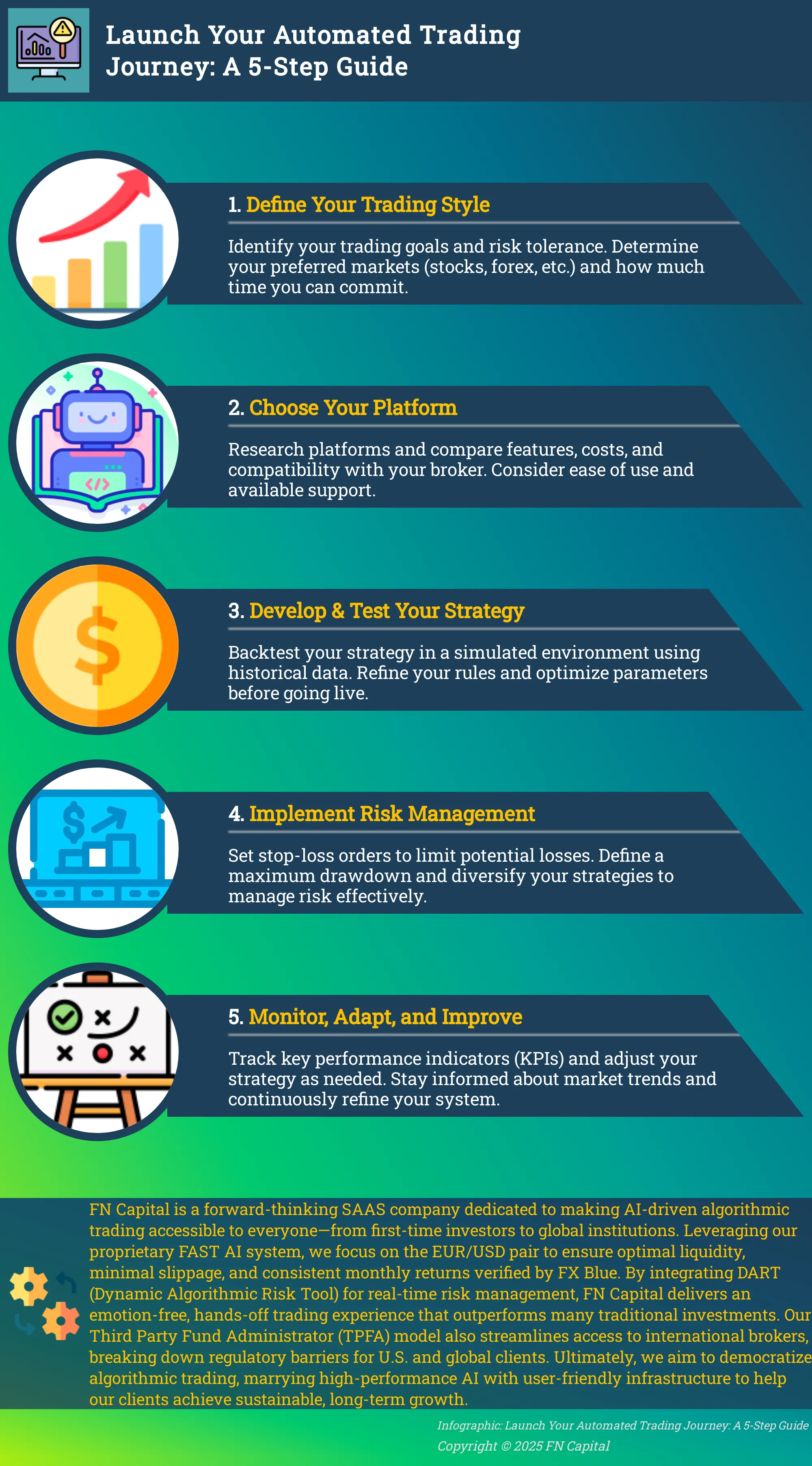
Define Your Trading Goals and Experience
Before browsing platforms, define your trading goals. Are you a beginner exploring algorithmic trading with limited capital, or an experienced trader automating a complex strategy? Your experience level is key. Some platforms cater to beginners with user-friendly interfaces and educational resources, while others provide advanced features and scripting for experienced programmers. Knowing where you stand helps narrow your options. Consider what markets you want to trade (stocks, forex, futures, etc.), your risk tolerance, and how much time you’re willing to dedicate to managing your automated system.
Evaluate Platform Features and Compatibility
With a clear understanding of your goals and experience, you can evaluate platforms. Look for features aligning with your trading style and target markets. Do you need multi-asset support? Is backtesting important? Consider platforms like QuantConnect, offering a cloud-based platform with multi-asset support, backtesting, and a large dataset library. Another option is Tickblaze, a hybrid platform with advanced scripting in C# and Python. Ensure the platform is compatible with your brokerage accounts and other trading tools. Think about order types, charting capabilities, and any specific technical indicators you rely on.
Consider Costs and Pricing
Automated trading platforms have different pricing models. Some offer free accounts with limited features, while others charge monthly or annual fees. QuantConnect provides a free account, letting you explore before committing to a paid plan. Tickblaze offers a free option for retail traders and a paid version with advanced features. Factor in these costs and the value you receive. Account for additional costs like data fees or exchange connectivity charges. If you’re just starting, a free or low-cost platform might be sufficient. As your needs grow, you can upgrade to a more sophisticated platform.
Examine Customer Support and Resources
Reliable customer support and educational resources are essential, especially for beginners. Seek platforms offering responsive customer service, helpful documentation, and active communities. QuantConnect offers a “Build vs. Buy” calculator to assess cost-effectiveness. Tickblaze provides live trader education with access to live trading rooms and instructors. A supportive community can be invaluable, offering a space to connect with other traders, share ideas, and troubleshoot. Consider the availability of support channels (email, phone, live chat) and the platform’s overall reputation for customer service.
Best Practices for Automated Trading
Getting started with automated trading can feel like a big step. Here’s how to approach it strategically and manage risk effectively.
Test Strategies in Simulated Environments
Before risking real capital, test your automated trading strategies in a simulated environment. Think of it as a dress rehearsal for your trading bot. This allows you to see how your strategy performs under various market conditions without financial consequences. Most platforms offer a paper trading account, which mirrors live market data but uses virtual funds. This practice lets you observe your strategy’s behavior, identify potential flaws, and refine it before going live. Thorough testing is key to building confidence in your automated system.
Implement Risk Management
Automated trading can save you time and improve efficiency, but success hinges on proper risk management. Define clear risk parameters for your automated system. This includes setting stop-loss orders to limit potential losses on individual trades and establishing a maximum drawdown limit for your overall portfolio. Consider diversifying your automated strategies across different markets or asset classes to avoid overexposure to any single area. Remember, even with automation, risk is inherent in trading, so proactive management is essential.
Monitor and Maintain Your System
While automated systems run independently, ongoing monitoring and maintenance are crucial. Regularly review your system’s performance, checking for any unexpected behavior or deviations from your planned strategy. Market conditions change constantly, so periodically validate and adjust your system. This might involve tweaking parameters, updating algorithms, or even adding new rules based on market analysis. Consistent oversight will help ensure your automated system remains effective and aligned with your trading goals.
Adapt to Changing Markets
Markets are dynamic, influenced by news, economic shifts, and global events. Your automated trading system needs to be flexible enough to handle these changes. Stay informed about market trends and adjust your strategies accordingly. This might involve incorporating new data points into your algorithms, refining your risk management rules, or even temporarily pausing your automated trading during periods of high volatility. The ability to adapt is crucial for long-term success in automated trading. A static system can quickly become outdated and ineffective as markets evolve.
Key Performance Indicators for Automated Trading
Picking the right automated trading software is only half the battle. Understanding how to measure its success is crucial for long-term profitability. Here’s a look at the key performance indicators (KPIs) you should be tracking:
Win Rate and Profit Factor
Win rate is simply the percentage of your trades that close in profit. While a high win rate might sound appealing, it doesn’t tell the whole story. You could have a high win rate with small profits, but a few large losses could wipe those gains out. That’s where the profit factor comes in. This metric calculates the ratio of gross profit to gross loss. A profit factor above 1.0 indicates that your winning trades generate more profit than your losing trades lose—a fundamental requirement for any successful strategy. Used together, win rate and profit factor provide a more complete picture of your system’s performance.
Maximum Drawdown
Maximum drawdown measures the largest peak-to-trough decline in your trading account balance. It’s an essential metric for understanding risk. A high maximum drawdown suggests your system is susceptible to significant losses during periods of market volatility. While some drawdown is inevitable, keeping it within acceptable limits is crucial for preserving your capital. Knowing your maximum drawdown helps you set realistic expectations and manage risk effectively.
Sharpe Ratio
The Sharpe Ratio helps you understand how much return you’re getting for the risk you’re taking. It compares your system’s excess return (return above a risk-free benchmark) to its volatility. A higher Sharpe ratio generally indicates a better risk-adjusted return. This means you’re achieving higher returns without taking on proportionally higher risk.
Execution Speed and Slippage
In the fast-paced world of automated trading, execution speed matters. Delays in order execution can lead to missed opportunities and reduced profitability. Slippage—the difference between the expected price of a trade and the price at which it’s actually executed—can also eat into your profits. Minimizing slippage is crucial for maximizing returns. Look for software that prioritizes speed and minimizes slippage to ensure you’re getting the best possible price on your trades.
Get Started with Automated Trading Software
Ready to explore automated trading? Here’s a straightforward guide to help you get started:
Set Up Your Trading Account
First, open a brokerage account that supports automated trading. This gives you access to the markets and the necessary tools. Many brokers offer different account types, so choose one that aligns with your capital and goals. Complete the required verification steps to activate your account.
Configure Your Trading Parameters
Next, define the rules for your automated trading system. This means setting the conditions for when your system buys and sells assets. A clearly outlined trading strategy is key. Consider factors like entry and exit points, position sizing, and stop-loss orders. Many platforms offer backtesting tools to test your strategy using historical data, giving you insight into potential live market performance.
Monitor and Adjust Your Strategy
After deploying your system, regular monitoring is essential. Markets constantly shift, so adjustments will likely be needed. Keep an eye on key performance indicators and be ready to tweak your parameters. Refine your approach based on real-world results. Consistent evaluation helps you identify areas for improvement and adapt to market dynamics.
Learn and Improve Continuously
Automated trading requires ongoing learning and improvement. Understanding key performance metrics and implementing robust risk management are essential. Stay updated on market trends, explore new strategies, and consider joining online communities to connect with other automated traders. Continuous learning helps refine your system and achieve your goals.
Related Articles
- How to Make Money with Automated Trading: A Practical Guide
- Practical Guide to Buying Algorithmic Trading Software
- Real-World Algorithmic Trading Examples & Strategies
- Algorithmic Trading Platforms: Your Complete Guide – FN Capital
- Automated Trading Returns: Strategies for Success
Frequently Asked Questions
Is automated trading suitable for beginners?
Automated trading can be beneficial for traders of all experience levels. For beginners, it removes the emotional aspect of trading and enforces a disciplined approach. However, it’s crucial to understand that automated trading isn’t a “set it and forget it” solution. You still need to learn about market dynamics, develop a sound trading strategy, and choose a platform that aligns with your goals and technical skills. Beginners might consider platforms with user-friendly interfaces, educational resources, and readily available customer support. Starting with small amounts of capital and thoroughly testing strategies in a simulated environment is also recommended.
What are the key risks of automated trading?
While automated trading offers many advantages, it’s important to be aware of the potential risks. Technical issues like internet outages or software glitches can disrupt trading activity. Over-optimizing a strategy based on historical data can lead to poor performance in live markets. Perhaps most importantly, automated trading doesn’t replace the need for market knowledge and understanding. A well-defined strategy is still crucial for success. It’s also important to be mindful of the psychological aspects of relying on automated systems and to avoid complacency.
How do I choose the right automated trading platform?
Choosing the right platform depends on several factors, including your trading goals, experience level, and budget. Consider what markets you want to trade (forex, stocks, futures, etc.), your risk tolerance, and the complexity of the strategies you plan to implement. Evaluate platform features like charting tools, backtesting capabilities, and available order types. Compare pricing models and ensure the platform is compatible with your brokerage accounts. Finally, research the platform’s customer support and available educational resources.
What are the most important performance indicators to track?
Several key performance indicators (KPIs) can help you evaluate the effectiveness of your automated trading system. The win rate shows the percentage of winning trades, while the profit factor measures the ratio of gross profit to gross loss. Maximum drawdown reveals the largest peak-to-trough decline in your trading account, providing insight into potential risk. The Sharpe ratio assesses risk-adjusted return, and execution speed/slippage are crucial factors impacting profitability. Monitoring these KPIs helps you understand how your system is performing and identify areas for improvement.
How can I mitigate risks in automated trading?
Risk management is paramount in automated trading. Thoroughly testing your strategies in a simulated environment before deploying them with real capital is crucial. Implement risk management tools like stop-loss orders to limit potential losses on individual trades. Define a maximum drawdown limit for your overall portfolio to protect your capital. Diversifying your automated strategies across different markets or asset classes can also help mitigate risk. Regularly monitor your system’s performance and adjust your strategies as needed to adapt to changing market conditions.
